The Tales of Pirates - Edward "Ned" Low
Edward Low was one of the pirates responsible for the stories of the pirate cruelty. He was neither among the most successful, nor among the most capable pirates of his time. He earned his notoriety by being one of the most vicious. He was a man who embodied all the worst characteristics we associated with pirates.
Although it is a popular belief that all pirates were murderers and torturers, that is far from the truth. Most of the pirates avoided mistreatment of the crews on the captured ships. Good treatment of the crew increased chances that future ships would surrender without a fight. Some of the most capable pirates, like Samuel Bellamy and “Blackbeard” are famous by the fact that there is no record of them ever murdering a sailor from the ship they captured.
Edward Low was a different kind of pirate. He was described as a maniac and a brute by his own crew. One of the theories about his fate states that his cruelty was his demise. Supposedly his crew mutinied against him and set him adrift without provisions.
Depiction of Edward "Ned" Low's Jolly Rogger
Life before piracy
Edward was born in Westminster, London in 1690. Even at a young age, he was a criminal. He was born into a family that consisted mostly of thieves. Besides thievery, he was said to collect tribute from other children in the neighborhood, and beating those who refused or failed to pay him. As a young adult, he became a pickpocket and a cheating gambler. When the money he gained from those lines of business weren’t enough, Edward turned to burglary.
In 1710 he traveled to North America for unknown reasons. He was moving from place to place until he settled in Boston, Massachusetts. There he met Eliza Marble whom he married on 12 August 1714. His married life was filled with tragedies. His son died as an infant, and his wife died in childbirth in 1719 leaving him alone with his daughter. Low left his daughter and went to work at sea. We don’t know what he did for a living since moving to America, but once he went to the sea he worked as a rigger.
A map of London and Westminster from 1982
In 1722 he changed employment and went to Honduras where he supervised the loading and carrying of the logs. This was his last legal employment in life. He and the twelve men under his command had a duty of taking Spanish logwood by force and bringing it to the ship. For that purpose, they were all well armed. On one occasion they were about to depart a bit before dinner was ready. Edward insisted that he and his men eat dinner before departing. The captain of the ship replied that they would have to be satisfied with a ration of rum as no time was to be lost. The crew was infuriated and Edward took a loaded musket and fired it at the captain. He missed the captain and killed another man. After this incident Low and his gang of twelve men left the ship, stole a sloop near Rhode Island and started their pirating career.
Career as a pirate
Edward Low’s first piracy happened on a shipping route between Boston and New York. There he captured a sloop that was traveling from Rhode Island. He plundered it and cut it’s rigging to prevent the crew from raising the alarm quickly. After plundering few more merchant ships there he headed towards the Grand Cayman. There he met the Captain of the Happy Delivery, established pirate George Lowther. Captain Lowther had a decent pirating ship which was armed with eight guns and weighed 100 tons.
Lowther persuaded Low and his crew to join forces with him for the mutual benefit. They accepted, and Edward Low became Lowther’s lieutenant. They sailed together for a few months; during that time Low, now in a position of power, discovered that he rather liked cruelty. He started inventing his own torture techniques. One of them consisted of tying hands of the victim with a fuse between victims fingers. The fuse would then be set alight and burn victim’s flesh to the bones.
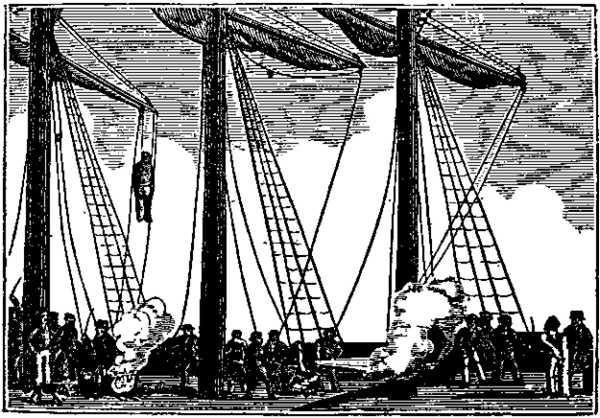
The cruelties practiced by Captain Low, 1837
During May 1722, the pirates captured the Rebecca, a large brigantine with six canons. Edward Low was named the captain of the newly acquired ship, and 44 crew members of the crew were assigned under his command. Soon after that Edward quit his partnership with Lowther and sailed away to pirate as an independent pirate captain.
The first few operations of the new pirate crew consisted of refilling their provisions. They would capture a ship, plunder it and allow it to depart. One of those ships reached Black Island and informed the governor about pirates on the coast. Two ships were sent in pursuit, but Low’s crew was long gone. They were on their way to the Port Rosemary where they committed their first more serious act of piracy.
In June 1722, with the Rebecca arrived to the Port Rosemary where thirteen fishing vessels were anchored. In order to capture the prey that vastly overpowered the pirates, Low used threats. He hoisted his Jolly Roger and sailed in the midst of the fishing vessels threatening that no mercy would be given to any man that resisted. The men on the fishing ships all submitted and Low picked the largest ship which he armed, renamed to The Fancy and turned into his flagship. Charles Harris was named the Captain of the Rebecca and Low’s pirates now had two ships at their disposal. They sank the rest of the fishing fleet and forced some of the fishermen to join them. One of those Fishermen was Philip Ashton. He was tortured aboard the ship for ten months because he refused to sign Low’s pirate code and join the pirates. He finally managed to escape when the pirated were anchored near Honduras. We owe much of what we know about Low to Ashton, as he later published a detailed novel about his time among the pirates.
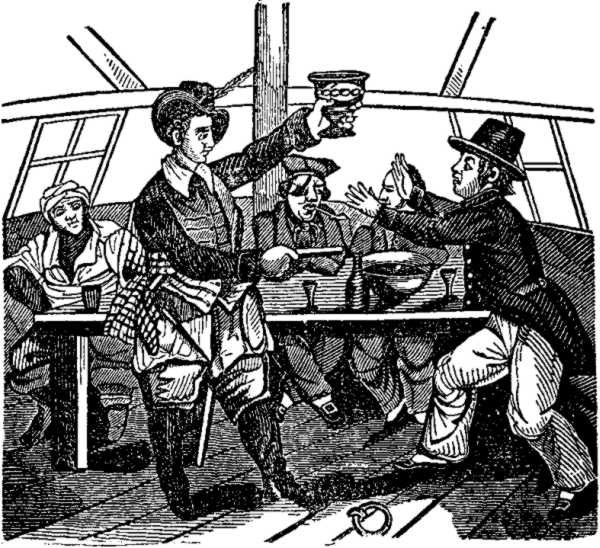
Edward "Ned" Low aboard his ship
With their increased power, the pirates went to the sea again; but luck didn’t serve them well in the next part of their adventures. They pursued two sloops from Boston but managed only to lose time and provisions as the sloops successfully escaped. Next stroke of the bad luck was running into a strong hurricane while they were sailing for the Leeward Islands. They barely survived the hurricane and were forced to throw six of the canons and lots of provisions overboard. On top of that, the two ships were separated during the hurricane and it took them some time to find each other again.
Exhausted from working day and night to survive the hurricane, the pirates ran into the last stroke of bad luck. That particular instant of bad luck appeared in the form of a fully armed English warship which pirates mistook for a fishing boat. They realized the mistake soon enough when they replaced their false colors with a black flag. As soon as they hoisted the Jolly Roger the warship opened fire. The pirates narrowly escaped and went to a small island in the Western Caribbean. There they refilled provisions and went on a cruise with the Rebecca while The Fancy was being prepared for the sea. They had a short-lived change of luck during that cruise. They ran into a ship which was floating dead in the sea, all its masts destroyed by the same hurricane they narrowly escaped. Plundering the ship they returned to The Fancy.
The decision was made to sail for the Azores. At the beginning of the journey, Low managed to capture a French warship with 34 canons which he renamed the Rose Pink and refitted it as his new flagship. Among the other ships, he captured on the way there were a few Portuguese passengers who unluckily saw the crueler side of Low. For no apparent reason, besides cruelty and fun, Captain Low ordered them hoisted up and dropped down from the yardarm until they died. Plundering a few more ships and committing some other atrocities (including burning a ship with the ship’s cook tied to the mast because he “being a greasy fellow, would fry well”), the pirates were on their way to Surinam from where they intended to sail over the Atlantic to the Azores.
Downfall and death
In Surinam Edward Low intended to careen the Rose Pink and prepare her for a long journey. None of the pirates had experience operating such a large ship and they placed too many men to the outside working on the buildup. In addition, the portholes had been left open. When the ship started tipping over too far, the water started pouring inside and the Rose Pink capsized. The Rose Pink carried most of the provisions and those sunk along with the ship. With no provisions and having lost their flagship, Edward Low was forced to change his planned route.
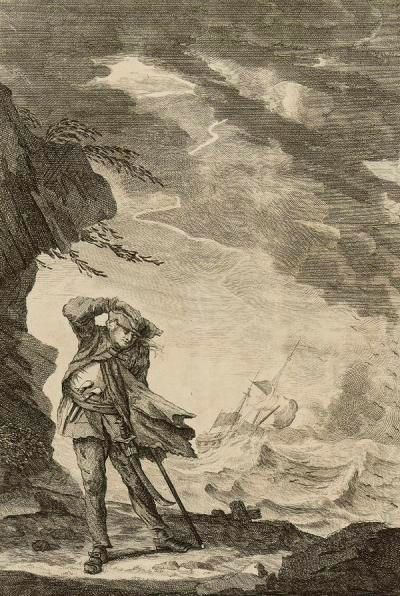
An image of Edward "Ned" Low from the National Maritime Museum in London
Having been left only with a small schooner the Squirreland almost no provisions, the crew sailed to Grenada. The conditions on the ship were harsh and little of what was left of their provisions was strictly rationed (each man was entitled only to half a pint of water per day). Once they arrived at Grenada, Low hid his men below the deck and he was permitted to send a few of men ashore for water. When the French sent a sloop to investigate the Squirrel they were captured. Low had acquired a usable ship again, but that was not the end of his troubles. Low’s quartermaster, Francis Farrington Spriggs got into a fight with Low over Low's cruel treatment of one of Spriggs' men. The fight didn't end well and Spriggs left him. He took the Squirrel with him, and lots of Low's men followed Spriggs.
Low managed to capture some more ships and his flotilla increased in numbers once again, but he soon met his end. On 10 June 1723, HMS Greyhound, a heavily armed warship caught up with them. Greyhound’s mission was specifically to hunt down Low. In that battle, pirates have suffered a heavy defeat, and Low escaped. In order to escape he left behind half of his crew that was on his other ship captained by his second in command, Charles Harris.
There are two different reports on what happened to Low in the end. A General History of the Pyrates claims that he sank along with his ship during the storm close to Brazil. The Pirates Own Book states that Low was set adrift by his crew as they could no longer tolerate his cruelties.
Flags
For the end here is a little story about flags used by Edward Low. Most of the pirates who had their flags made usually had black or red flags so I couldn’t resist mentioning Low’s green flag.
Depiction of Edward "Ned" Low's flag used for calling the captains for the meetings
The flag in the first picture of this article is first Low’s original flag, but not the first one he used. Before he created his own flag he used the same flag as “Blackbeard”. Besides the Jolly Rogger, Low used a green silk flag with a yellow trumpeter on it. That flag was used to call captains of the other ships in his fleet to the meetings.
Sources
- A General History of the Pyrates - 1724, Captain Charles Johnson
- The Pirates Own Book: Authentic Narratives of the Most Celebrated Sea Robbers - 1837, Charles Ellms
- Wikipedia
Previous post from the series:

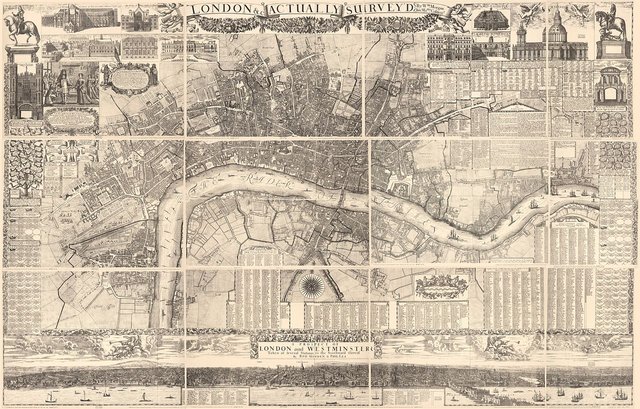
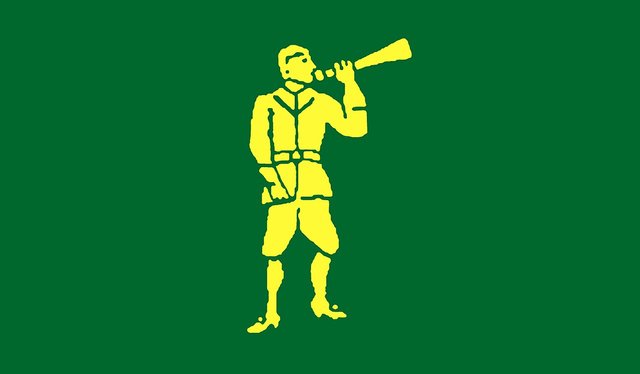
A nice post in my eyes 😊 Resteemed by @peekbit to say “thank you“ since you are one of my esteemed followers.
Read about my attempt in contributing to the bright side of life.
Some remarks about my resteeming.
Thanks, I will drop by your blog to say hi :)
oh thank you... and I hope you enjoy the views... 😊 @peekbit
This is a lovely surprise! Hats off to you captain, thanks for sharing with us during the show. Good luck to your game!
Thanks :)
This gets me in the mood to go watch pirate of the Caribbean! The pirate culture is something that always intrigued me, i think there should be more movies about the great pirates that the world had.
Just one question, he never got to azores right? i guess azores was probably a nice place for pirates since it's in the middle of the ocean
I loved the first three movies in the pirate of the Caribbean series, but each later movie was just worse than one that came before... There is a really good tv-series about pirates (Black Sails) and much of it is based on history. I still haven't finished it, but I loved the first few episodes that I watched.
He actually did get to Azores, but not many notable things happened there (besides successful plundering) so I didn't write about it. That was the problem with the Azores, if you were being hunted there as a pirate there was no other close place to resupply. Bahamas were the heaven for pirates. They were split between Spanish, French and English jurisdictions and had a strong winds which didn't allow big warships to sail as much windward as smaller pirate sloops could. :) At some point I will write a detailed post about some of the ideal locations for pirating during the golden age. 🏴☠️
This is a very interesting and informative article, thanks for sharing! I think it's really interesting—and very savvy—that they had a special flag for captain meetings.
We may never know the truth of how he died, but given the cruelty of Ned Low and his continual mismanagement of his fleets, I wouldn't be at all surprised if his crew set him adrift!
That is the more probable of the options, as more sources are pointing in that direction than on a possibility that he sunk during the storm. Thanks for taking the time to read :)
Thanks for another awesome pirates tale. After reading this I want to go watch Black Sails again. ;0)
I still have to finish the series for the first time. I started watching it when it came out, and I stopped for some reason that I no longer remember.
Arrrrr, @dreemsteem should take a look at this, arrrrrrrr...
Thank you for another very educational post, they are always a pleasure to read.
Thanks for reading! :)
This was such a fun read, and a very fascinating topic. This fellow seems to be very crafty! His cruel run is longer than I would have expected too, but I guess fear is a powerful motivator in that line of crime anyway.
Yup, the guy had a lot of luck. He went pirating with almost no experience at the sea, and his crew was no better. It is a wonder that their ship didn't sink in a first few weeks!
Great post. I love reading about the ancient pirates and seafaring stories.
Me as well :) I intended to write about Benjamin Hornigold today, but I found a new book about him. He will have to wait until the next week so I can finish the book and possibly find some info about him I didn't know. Drop by next week if you are interested in "Blackbeards" mentor! 🏴☠️
Pirates were the rebellions of the seas they thought everything on water was there right and looted just about any ship they could the life lived by them was epic and full of adventures.
Not all of them acted that way. I hope I will finish the book I am reading at the moment and write an article about Captain Hornigold next. He owes his success and survival for avoiding ships from certain countries. His plan was to claim he was a privateer and not a pirate if he was ever caught by English authorities :)
Congratulations, your post was discovered and featured by @OCD in its daily compilation 238!
You can follow @ocd – learn more about the project and see other Gems! We strive for transparency.
If you would like your posts to be resteemed by @ocd to reach a bigger audience, use the tag #ocd-resteem. You can read about it here.
@ocd now has a witness. You can vote for @ocd-witness with SteemConnect or on Steemit Witnesses to help support other undervalued authors!